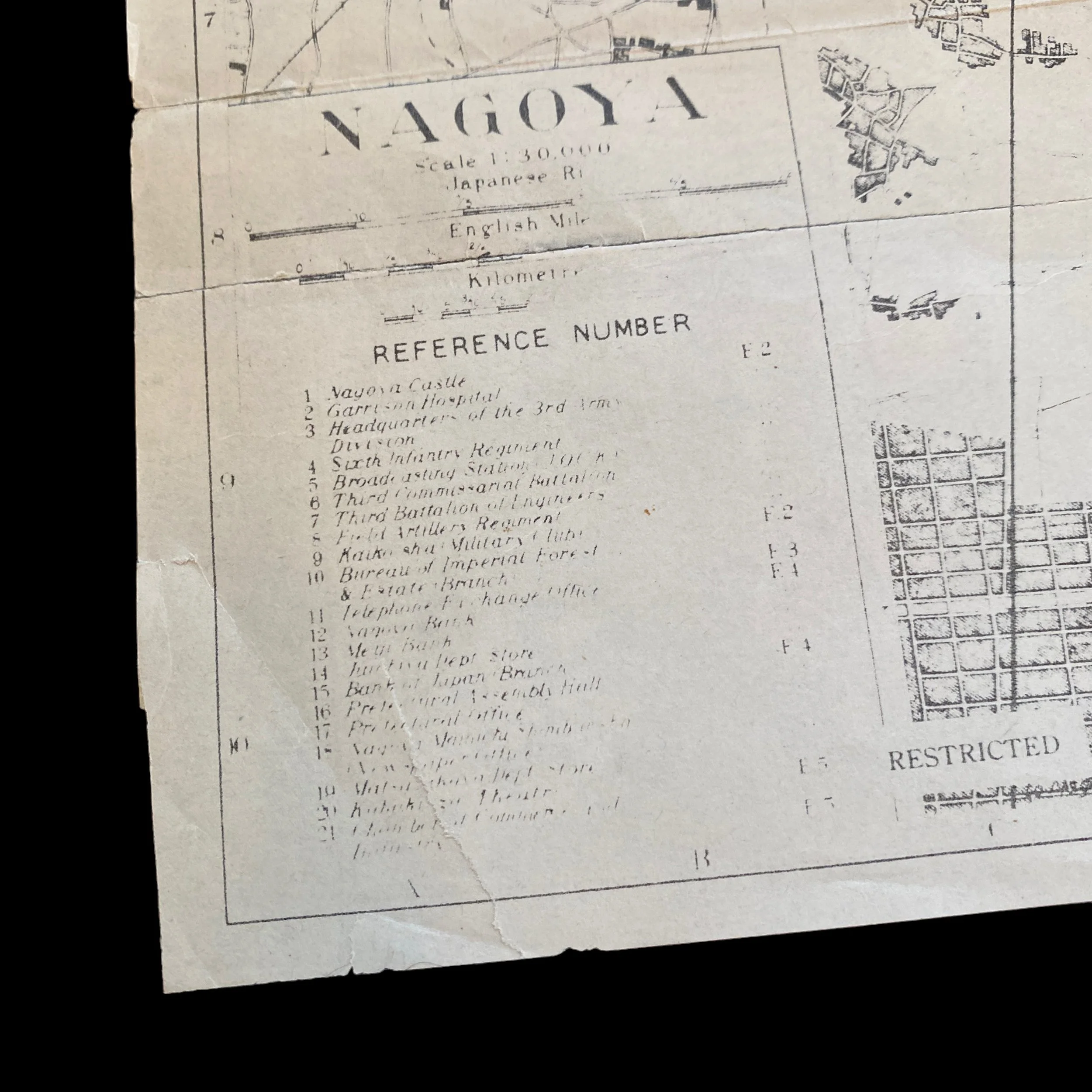WWII 1945 "Nagoya" Mainland Japan Pacific Theater U.S. Map*
















WWII 1945 "Nagoya" Mainland Japan Pacific Theater U.S. Map*
Comes with hand-signed C.O.A.
This incredibly rare and museum-grade WWII U.S. map of Nagoya is dated 1945 and shows one of mainland Japan’s most infamous city that saw widespread destruction during WWII.
World War II stands as one of the darkest chapters in human history, marked by widespread devastation, loss of life, and untold suffering. Among the many cities affected by this global conflict, Nagoya, a major industrial center in Japan, played a significant role. With its strategic importance and industrial prowess, Nagoya became a prime target for Allied bombing campaigns, culminating in a devastating climax in 1945.
Pre-War Nagoya:
Nagoya, situated in the Chubu region of Japan, had long been renowned for its industrial strength. Even before the outbreak of World War II, the city was a hub of manufacturing, particularly in the automotive and aerospace industries. Companies like Mitsubishi Heavy Industries and Toyota had their roots firmly planted in Nagoya, contributing to its reputation as an economic powerhouse.
As tensions escalated globally in the late 1930s, Nagoya's industrial might became increasingly vital to Japan's war effort. Factories churned out military equipment, including aircraft, munitions, and naval vessels, playing a crucial role in supporting Japan's military ambitions in the Pacific theater.
The Allied Bombing Campaign:
With its industrial infrastructure and strategic significance, Nagoya became a prime target for Allied bombing raids. Beginning in 1942, Allied forces launched a series of air raids aimed at crippling Japan's industrial capacity and undermining its war effort. These raids intensified as the war progressed, with Nagoya bearing the brunt of the devastation.
The bombing raids inflicted significant damage on Nagoya's industrial complexes, with factories, warehouses, and transportation networks all coming under relentless assault. The Mitsubishi aircraft manufacturing plant, a key target due to its production of Zero fighter planes, was repeatedly hit, disrupting production and causing widespread destruction.
1945: The Climactic Year:
By 1945, as the tide of the war turned against Japan, Nagoya found itself facing increasingly ferocious bombardments. The year began with a relentless series of air raids, as Allied forces sought to cripple Japan's war machine and hasten the end of the conflict.
In March 1945, the devastating firebombing campaign known as Operation Meetinghouse struck Nagoya with unparalleled ferocity. Waves of B-29 bombers unleashed an inferno upon the city, dropping thousands of tons of incendiary bombs designed to ignite a firestorm. The resulting conflagration engulfed vast swathes of Nagoya, reducing entire neighborhoods to ash and rubble.
The firebombing of Nagoya had a catastrophic impact on its civilian population, with tens of thousands perishing in the flames or succumbing to injuries and suffocation. The city's once-thriving urban landscape was transformed into a wasteland of devastation, as survivors struggled to comprehend the scale of the destruction wrought upon their homes and communities.
Despite the overwhelming devastation, Nagoya's spirit remained unbroken. In the aftermath of the firebombing, survivors banded together to rebuild their shattered city, demonstrating remarkable resilience in the face of adversity. Amidst the ruins, makeshift shelters and emergency relief efforts provided a lifeline for those left homeless and destitute.
The End of the War and Rebuilding:
The final months of World War II brought further hardship and suffering to Nagoya, as the city endured continued bombardments and the escalating horrors of conflict. However, the dropping of atomic bombs on Hiroshima and Nagasaki in August 1945 ultimately led to Japan's surrender, bringing an end to the war and ushering in a new era of reconstruction and recovery.
In the aftermath of the war, Nagoya emerged from the ashes determined to rebuild and revitalize itself. With the support of the Japanese government and assistance from the international community, the city embarked on a comprehensive reconstruction effort, restoring its industrial infrastructure and urban fabric.
The post-war years saw Nagoya undergo a rapid transformation, as it embraced modernization and economic development. The automotive and aerospace industries, which had suffered grievous losses during the war, rebounded with renewed vigor, propelling Nagoya to new heights of prosperity and innovation.
Conclusion:
The story of Nagoya during World War II is one of resilience, sacrifice, and renewal. From its pivotal role in Japan's war effort to the devastating toll of Allied bombings and the arduous process of reconstruction, Nagoya's wartime experience left an indelible mark on its history and collective memory.
Despite the immense challenges and hardships endured, Nagoya emerged from the crucible of war with its spirit intact, embodying the resilience and determination of its people. Today, as a vibrant metropolis and center of industry, Nagoya stands as a testament to the power of human perseverance in the face of adversity.